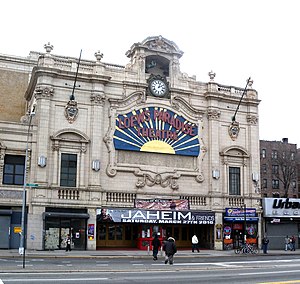Paradise Theater (Bronx, New York)

In 2010
|
|
| Address | 2403 Grand Concourse The Bronx, New York City USA |
|---|---|
| Coordinates | 40°51′37″N 73°53′54″W / 40.860337°N 73.89842°W |
| Type | Atmospheric theatre |
| Capacity | 3,885 |
| Current use | Church |
| Construction | |
| Opened | September 7, 1929 |
| Rebuilt | 1973, 1975, 1981, 2000, 2005, 2009 |
| Years active | 1929-1994, 2005-present |
| Architect | John Eberson |
| Website | |
| http://www.worldchangerschurchnewyork.org/locations.aspx | |
The Paradise Theater, formerly Loew's Paradise Theatre, is a movie palace-type theater located at 2403 Grand Concourse in Bronx, New York. Constructed in 1929 at the height of grand movie theaters, in the later 20th century the building was used also for live entertainment. It was leased in 2012 for use by the World Changers Church International New York, based in Fulton County, Georgia, for founding a local congregation.
Loew's Paradise Theatre opened on September 7, 1929 with Warner Oland in the film The Mysterious Dr. Fu Manchu on the screen, plus a stage presentation "Cameos" produced by Chester Hale, and British organist Harold Ramsey playing the 4-manual, 23-rank Robert Morton "Wonder Organ". The Paradise was originally commissioned by the Paramount-Publix theater chain and was slated to be named the Venetian Theatre. Paramount-Publix withdrew from the project shortly before construction began and it was taken over by New York's largest movie theatre chain, Loew's Theatres. The theater was promoted as one of the five "Loew's Wonder Theatres".
The first "Wonder Theatre", opened in January 1929, was Loew's Valencia Theatre in Jamaica, Queens. Loew's Paradise Theatre in the Bronx opened on the same day as Loew's Kings Theatre in Brooklyn. These were followed by Loew's Jersey Theatre in Jersey City, New Jersey, and finally Loew's 175th Street Theatre in Washington Heights, Manhattan. The Loew's Paradise Theatre was one of the last theatres built in the Atmospheric style toward the end of the "movie palace" building boom. The theater's architect, John Eberson, was famed for creating the Atmospheric theater design, which gave the illusion of an outdoor villa courtyard under a night sky. The Paradise is one of the best remaining examples of his work. Many of his other elaborate designs, including the Paradise Theatre in Chicago (1928–1956), have been demolished.
...
Wikipedia
